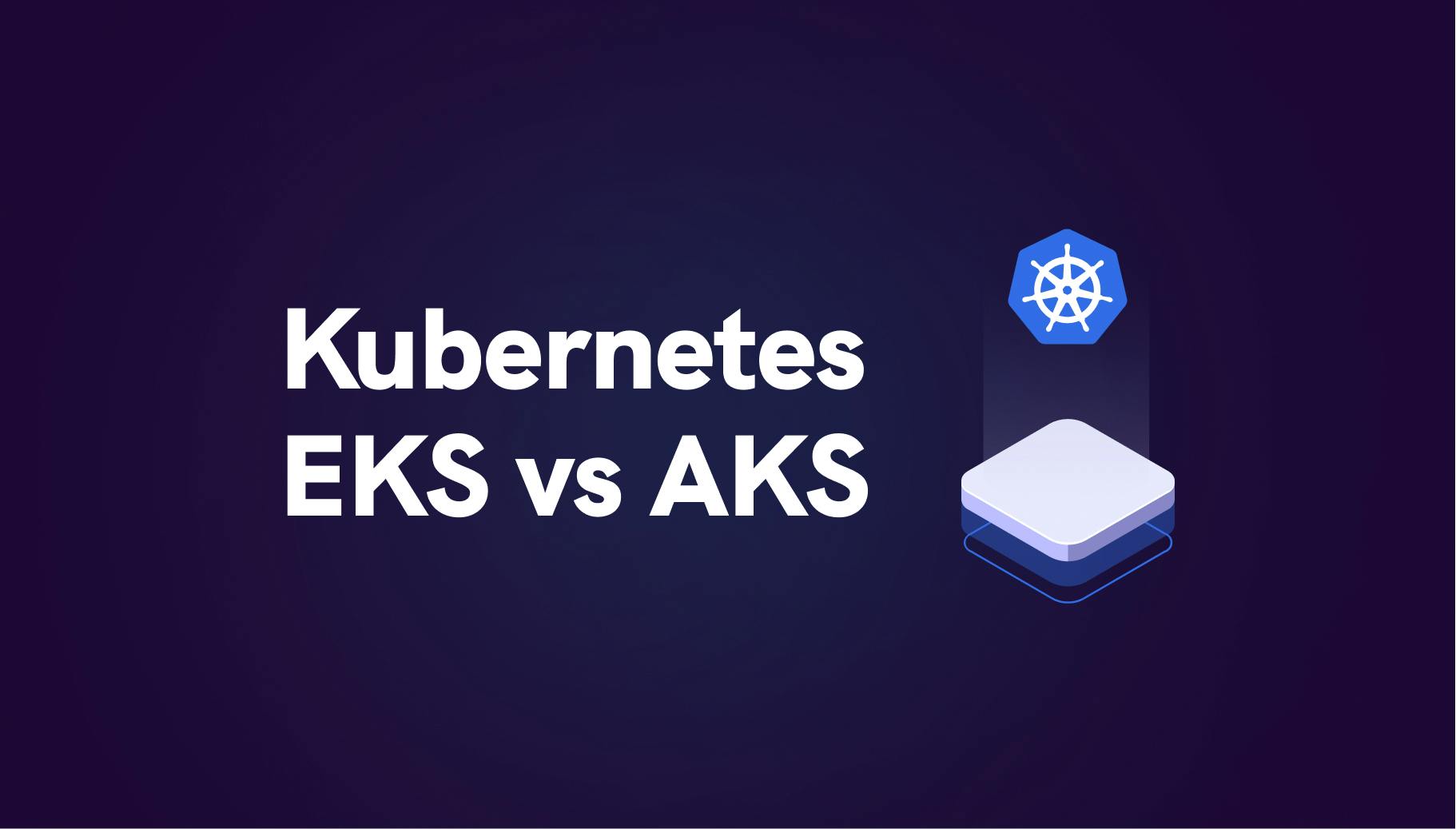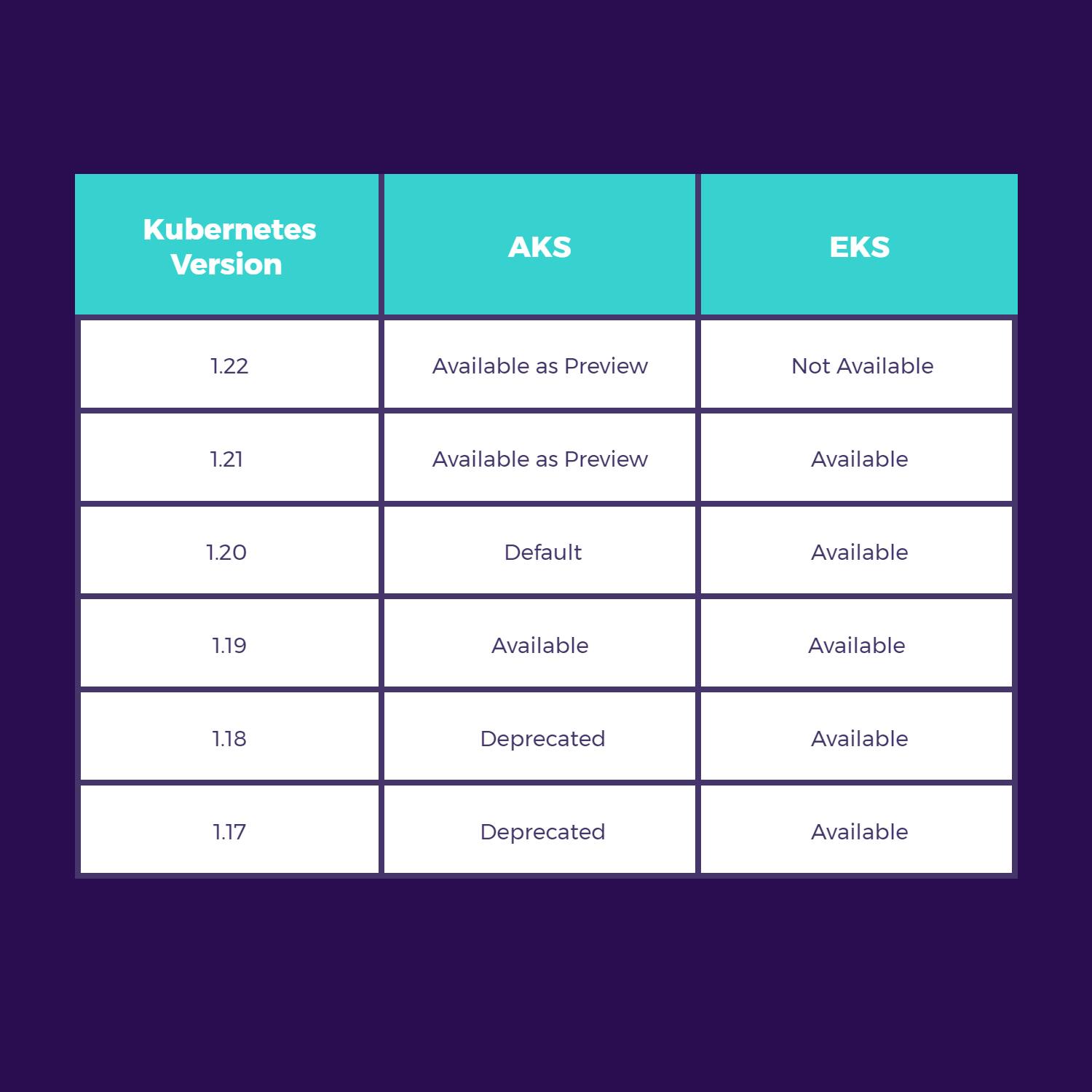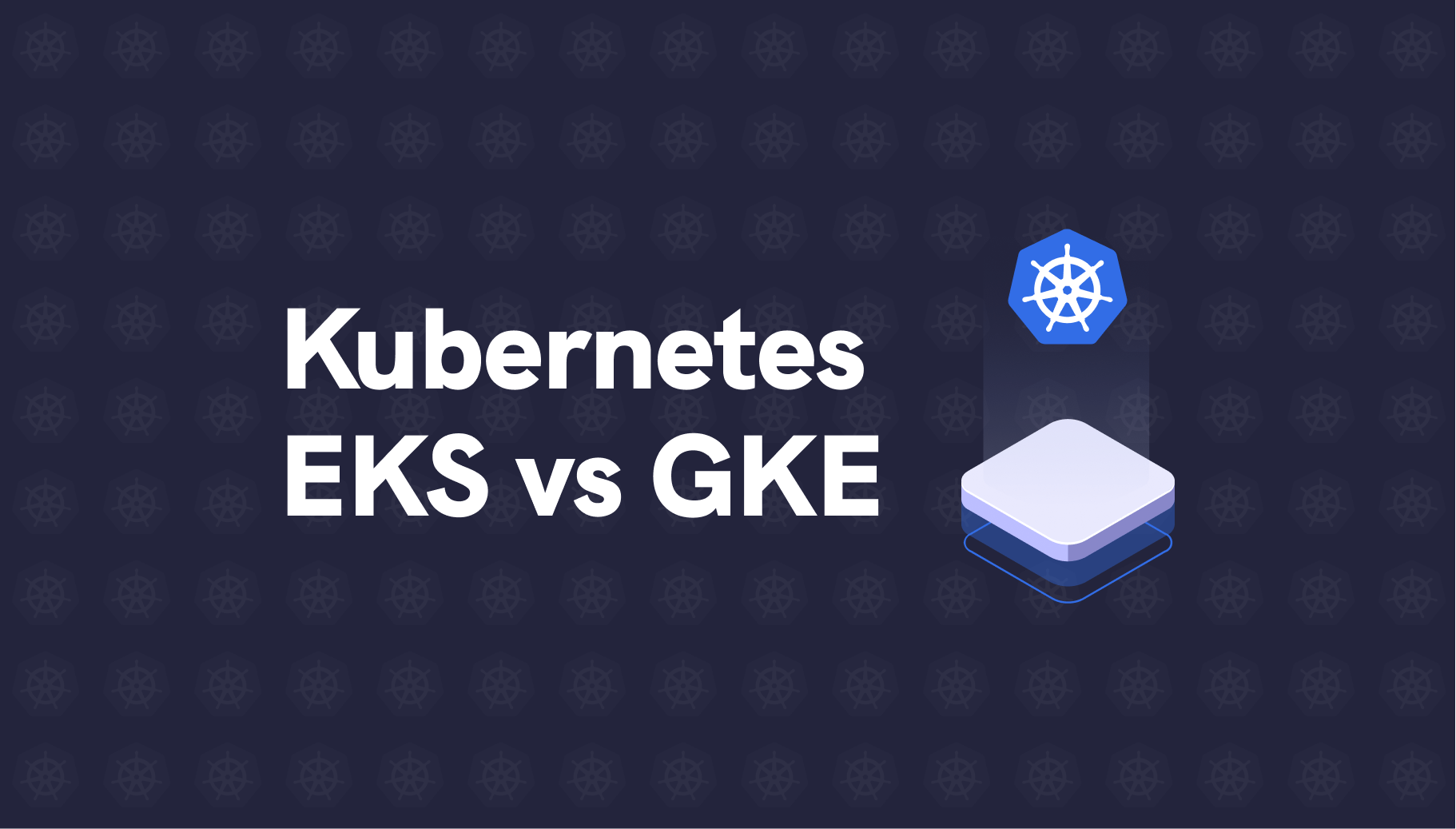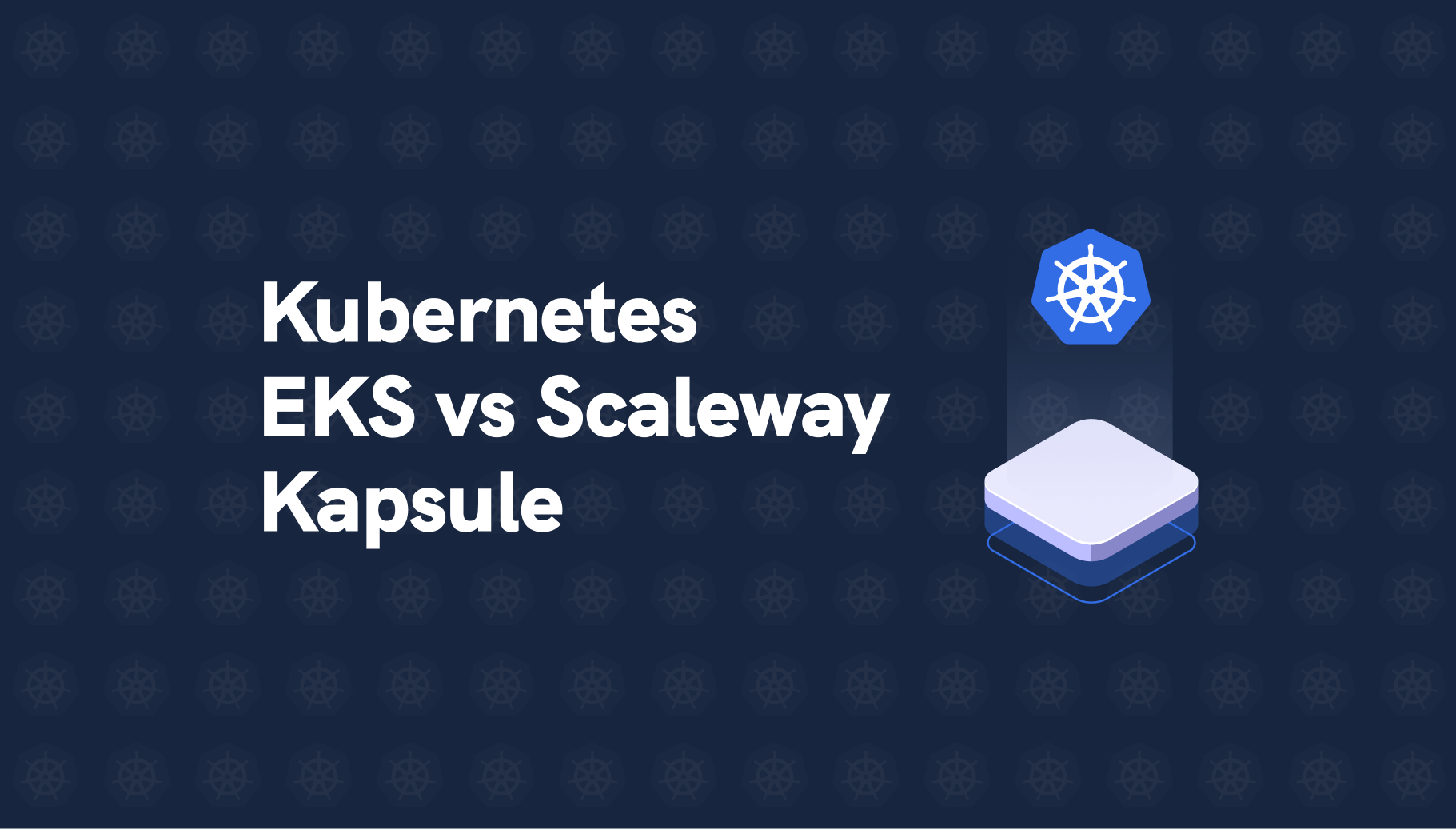EKS vs. AKS: Key Differences & Which Managed Kubernetes is Right For You?
Compare the differences between AWS (EKS) & Azure Kubernetes (AKS) for scalability, cost, and features. Discover how Qovery simplifies K8s management, accelerating your delivery on both platforms.

Romaric Philogène
May 1, 2025 · 12 min read
#Key Points:
- Kubernetes (K8s) is the leading container orchestrator, with a massive and growing community, making managed K8s services essential for businesses to focus on application logic, not infrastructure.
- This article compares the differences between Azure Kubernetes Service (AKS) from Microsoft Azure and Amazon Elastic Kubernetes Service (EKS) from AWS, two of the most popular managed Kubernetes offerings, examining their features, quotas, costs, and unique attributes.
- Both AKS and EKS are mature, production-grade solutions, with the choice often depending on existing cloud ecosystem experience, specific versioning needs, and the importance of features like auto-repair nodes (AKS) or extensive host OS options (EKS).
Despite its popularity, Kubernetes is a complex technology. Businesses of all sizes thrive on business logic, and developers are generally more effective at crafting this logic than at maintaining cluster operations or building production clusters from scratch.
A fully managed Kubernetes platform addresses this by allowing you to focus on your application, while the cloud provider handles resource availability, security, and deployment. The provider ensures resources are deployed at your desired geolocation and adds necessary compute. This lets your team concentrate on application development and deployment, not the underlying operations.
#Core Platform Details: Kubernetes Versions & Runtime Support
When it comes to supporting the latest Kubernetes versions and underlying container runtimes, EKS and AKS have distinct approaches.
Amazon Elastic Kubernetes Service (EKS)
- Kubernetes Versions: Doesn't support the latest upstream immediately; default cluster versions are typically a couple of months older than upstream.
- Container Runtime: As of November 2021, EKS primarily supported Docker as its only container runtime.
Azure Kubernetes Service (AKS)
- Kubernetes Versions: Supports a rapid stream of new versions, with older versions being deprecated more quickly.
- Container Runtime: Has progressed to support containerd from version 1.19, showing a faster adoption of newer runtime standards.
As of November 2021, these are the versions supported by them:

You can track the development of containerd here for EKS.
#Scalability Limits & Resource Quotas
Understanding the maximum capacities and resource quotas is crucial for determining if your workloads are a good fit for each environment.
#Amazon Elastic Kubernetes Service (EKS)
- Maximum Number of Clusters per Region: Up to one hundred clusters (can be increased by contacting AWS).
- Maximum Nodes per Cluster: Limited to 450 nodes per Node Group, with up to thirty Node Groups, totaling a maximum of 13,500 nodes.
- Maximum Node Pools: Supports up to thirty node pools.
- Maximum Pods per Node:
- Strictly 110 pods if AWS-CNI is earlier than 1.9.0 or if using alternative CNIs (Cilium, Calico, Weave Net, Antrea).
- Otherwise, dependent on Elastic Network Interfaces (ENIs) allowance, calculated by (# of ENI * (# of IPv4 per ENI - 1) + 2).
#Azure Kubernetes Service (AKS)
- Maximum Number of Clusters per Region: No specific regional limit, but sets one thousand as the maximum number of clusters for a user account.
- Maximum Nodes per Cluster: Limited to one thousand nodes across all node pools.
- Maximum Node Pools: Recently started supporting up to ten node pools.
- Maximum Pods per Node: Supports a maximum of 250 pods per node; each node is allocated a subnet of 254 hosts (/24) with 250 IP addresses for pods and four spare IPs.
You can read more about the numbers in this file from AWS and calculate it using the following formula:
Mapping is calculated from AWS EC2 API using the following formula:
* First IP on each ENI is not used for pods
* +2 for the pods that use host-networking (AWS CNI and kube-proxy)
# of ENI * (# of IPv4 per ENI - 1) + 2
#Pricing Models & Cost Optimization
Pricing for managed Kubernetes includes two main components: the control plane and the underlying hardware.
#Amazon Elastic Kubernetes Service (EKS)
- Control Plane Cost: Charges $0.10 per hour per control plane, which adds up to an extra $72 per month for a cluster.
- Hardware Cost: Pricing for bandwidth, storage, and virtual machines (EC2 instances) depends on specifications and region.
- Optimization: Offers cost savings through Savings Plans, Reserved Instances, and Spot Instances.
#Azure Kubernetes Service (AKS)
- Control Plane Cost: Does not charge for the control plane itself.
- Uptime SLA Cost: Offers an optional Uptime SLA which costs $0.10 per hour per cluster (also totaling $72 per month), ensuring higher availability.
- Hardware Cost: Pricing for bandwidth, storage, and virtual machines (Azure VMs) depends on specifications and region.
- VM Requirements: AKS requires nodes to use VMs with more than two CPUs for sufficient compute resources (e.g., Standard_D1, Standard_A0 are not suitable).
- Optimization: Offers cost savings through Reserved VM Instances.
#Cluster Management & Operational Ease
Both AKS and EKS support manual and automatic cluster and worker node upgrades, but their execution and other operational features differ.
#Amazon Elastic Kubernetes Service (EKS)
- Cluster & Worker Node Upgrades: Upgrades are generally less straightforward, requiring several command-line instructions.
- Host OS Support: Supports Amazon Linux 2, Ubuntu, Bottlerocket, and Windows for node creation. Bottlerocket is a Kubernetes-focused OS for optimization.
- Support for GPUs: Yes, EKS clusters support GPUs.
- Auto-Repair Nodes: Does not currently support auto-repair nodes.
- Bare Metal: Does not currently support bare metal clusters.
- Cluster Stop/Start: Clusters can be stopped and started using Azure portal/CLI/SDKs, preserving state (charges for resources like storage/IPs may continue).
#Azure Kubernetes Service (AKS)
- Cluster & Worker Node Upgrades: Upgrades are generally straightforward.
- Host OS Support: Supports Ubuntu 18.04 and Windows Server for node creation.
- Support for GPUs: Yes, AKS clusters support GPUs. Notable for training large models like GPT-3, CLIP, and DALL·E.
- Auto-Repair Nodes: Automatically scans and repairs unhealthy nodes, a feature currently unique to AKS.
- Bare Metal: Does not currently support bare metal clusters.
- Cluster Stop/Start: No built-in feature to stop/start the entire cluster; must scale down worker nodes to zero (control plane still charged) or delete and recreate.
#High Availability & Uptime Guarantees (SLAs)
Service-level agreements (SLAs) set uptime expectations for highly available applications, a major reason for cloud provider adoption.
#Amazon Elastic Kubernetes Service (EKS)
- SLA: Offers a 99.90% uptime SLA, assuring customers a maximum of 3.65 days of downtime per year.
#Azure Kubernetes Service (AKS)
- SLA: Offers a 99.9% SLA (maximum 8.77 hours of downtime per year).
- Enhanced SLA: Provides 99.95% SLA (maximum 4.38 hours of downtime per year) in ten specific Azure regions (Central US, East US 2, East US, West US 2, Central Japan, East-North Europe, Southeast Asia, UK, South-West Europe, France).
#Autoscaling Capabilities & Flexibility
Cloud providers ensure they can manage demand as it arises, and both AKS and EKS support autoscaling features for your workloads.
#Amazon Elastic Kubernetes Service (EKS)
- Cluster Autoscaling: Supports Cluster Autoscaler with configurable autoscaling profiles.
- Vertical Pod Autoscaling: Support for Vertical Pod Autoscaling (VPA) may vary or have specific configurations.
- Serverless Node Integration: Integrates with AWS Fargate, allowing running pods without provisioning or managing underlying EC2 instances/worker nodes.
#Azure Kubernetes Service (AKS)
- Cluster Autoscaling: Supports Cluster Autoscaler with configurable autoscaling profiles.
- Vertical Pod Autoscaling: Does not support vertical pod autoscaling as of the provided information.
- Serverless Node Integration: Integrates with Azure Container Instances (ACI) via "Virtual Nodes," allowing running pods without managing underlying VMs.
#Security Features & Compliance Posture
Cloud providers assume much of the security burden. Both AKS and EKS are robust in security, but with some distinctions.
#Amazon Elastic Kubernetes Service (EKS)
- Security Features: Supports Secrets, RBAC (Role-based access control), and configurable IPs for clusters.
- Network Policies: Requires manual configuration of VPC CNI plugin; security policies managed through Kubernetes Network Policies or AWS Security Groups.
- Compliance: Fully updated with compliances like HIPAA, SOC, ISO, and PCI DSS.
#Azure Kubernetes Service (AKS)
- Security Features: Supports Secrets, RBAC, and configurable IPs for clusters. Goes a step further with support for confidential containers for running applications in secured and isolated environments with attestation.
- Security Patches: Has faced criticism for historical delays in delivering security patch updates (e.g., Azurescape), though commitments have been updated.
- Network Policies: Utilizes Azure Container Network Interface (ACI) by default; network policy enforcement can be enabled by default. Supports Azure Network Policies, Calico, Cilium.
- Compliance: Fully updated with compliances like HIPAA, SOC, ISO, and PCI DSS.
#Networking & Connectivity
Networking configurations define how pods communicate, how IP addresses are allocated, and how traffic enters and leaves the cluster.
#Amazon Elastic Kubernetes Service (EKS)
- CNI Plugin: Primarily uses the Amazon VPC CNI plugin, which assigns pods IP addresses directly from the VPC subnet.
- Network Policy: Policies are managed through Kubernetes Network Policies or AWS Security Groups.
- Ingress/Egress: Leverages AWS Load Balancers (ALB, NLB) for Ingress.
- Private Clusters: Supports running private clusters through VPC endpoints.
- Load Balancing: Provides basic support for L4 load balancing, and also offers L7 load balancing via ALB.
#Azure Kubernetes Service (AKS)
- CNI Plugin: Offers Azure CNI (Traditional, Pod Subnet, Node Subnet) and Kubenet (Overlay). Azure CNI assigns pod IPs from the VNet subnet, while Overlay conserves VNet IP space by assigning pods IPs from a logically separate CIDR.
- Network Policy: Network policy enforcement is enabled by default. Supports Azure Network Policies, Calico, Cilium.
- Ingress/Egress: Integrates with Azure Load Balancers and Azure Application Gateway for Ingress (note: Application Gateway integration might have limitations with certain CNI modes like Overlay).
- Private Clusters: Supports running private clusters using Private Link.
- Load Balancing: Provides basic support for L4 load balancing, but has a limitation in providing L7 load balancing natively in some configurations.
#Storage Options & Persistent Volumes
Applications often require persistent storage. This section compares the primary storage options and their integration.
#Amazon Elastic Kubernetes Service (EKS)
- Default Storage: Defaults to Amazon EBS (Elastic Block Store) volumes for block-level persistent storage.
- Other Options: Supports Amazon EFS (Elastic File System) for shared file storage (serverless, elastic) and Amazon FSx (Lustre, NetApp ONTAP) for high-performance parallel file systems.
- CSI Drivers: Requires installing CSI drivers (e.g., for EBS, EFS, FSx) and configuring IAM permissions for persistent volumes.
#Azure Kubernetes Service (AKS)
- Default Storage: Integrates seamlessly with Azure Managed Disks (AMDs) for block-level persistent storage, offering a balance of performance and cost.
- Other Options: Supports Azure Files for shared file storage and Azure Blob storage for object storage.
- Azure Container Storage (ACS): Emerging solution to bring more storage flexibility and potential cost savings by consolidating volumes onto larger disks.
#Monitoring & Observability Ecosystems
Monitoring health is critical for mission-essential applications, and both platforms offer integrated and external tooling options.
#Amazon Elastic Kubernetes Service (EKS)
- Service Mesh Support: Supports AWS App Mesh (vendor-specific, but less effort to deploy) as well as Istio.
- Load Balancing: Provides basic support for L4 load balancing, and also offers L7 load balancing.
- Monitoring Tools: Requires manual deployment of Prometheus for resource monitoring.
#Azure Kubernetes Service (AKS)
- Service Mesh Support: Supports all popular service meshes including Istio, Linkerd, and Consul.
- Load Balancing: Provides basic support for L4 load balancing, but has a limitation in providing L7 load balancing.
- Monitoring Tools: Integrates with Azure Monitor for automatic resource monitoring without manual deployment; includes Container Insights for resource-level details.
#Identity & Access Management (IAM)
Managing access to your Kubernetes clusters and the underlying cloud resources is paramount for security.
#Amazon Elastic Kubernetes Service (EKS)
- Integration: Deeply integrates with AWS Identity and Access Management (IAM).
- Access Control: Uses IAM roles for service accounts (IRSA) to allow Kubernetes service accounts to assume IAM roles, providing granular access to AWS resources.
- User Authentication: Kubernetes user authentication maps to AWS IAM users/roles.
#Azure Kubernetes Service (AKS)
- Integration: Integrates seamlessly with Azure Active Directory (AAD), now part of Microsoft Entra ID.
- Access Control: Leverages AAD for authentication and authorization to the cluster, often using Kubernetes RBAC integrated with AAD groups.
- User Authentication: AAD provides single sign-on (SSO) for cluster access.
#Serverless Container Integration
For running specific workloads or scaling rapidly without managing worker nodes, integration with serverless container services is key.
#Amazon Elastic Kubernetes Service (EKS)
- Integrates with AWS Fargate to allow users to run pods as serverless compute, where AWS manages the underlying EC2 instances. This is a launch type for EKS pods.
#Azure Kubernetes Service (AKS)
- Integrates with Azure Container Instances (ACI) through Virtual Nodes, allowing users to burst pods to ACI without provisioning more AKS nodes. ACI provides a single pod of Hyper-V isolated containers on demand.
#Community Support & Documentation Resources
Access to good documentation and an active community is vital for getting started and resolving issues.
#Amazon Elastic Kubernetes Service (EKS)
- Community Support: Has excellent community support.
- Documentation: Documentation is comprehensive but can be less structured, often burying important information within detailed paragraphs.
#Azure Kubernetes Service (AKS)
- Community Support: Features a very engaged community that provides active assistance.
- Documentation: Has the upper hand with very simple and extensive documentation, often structured as a learning path for easier onboarding and troubleshooting.
#Summary of EKS and AKS Considerations
Both AKS and EKS are mature, market-leading offerings. They possess all the main features required for a production-grade Kubernetes cluster, with extensive adoption by users and companies. The decision between the two requires careful consideration, based on your specific use case, architecture, and existing cloud ecosystem.
- Choose EKS if: You are heavily invested in the AWS ecosystem, require granular control over underlying EC2 instances, prefer a deep integration with AWS IAM for service accounts, or need specific features like FSx for Lustre.
- Choose AKS if: You are heavily invested in the Azure/Microsoft ecosystem, prioritize automated cluster management and simpler upgrades, require Windows Server container support, or value features like automatic node repair and easy Azure Active Directory integration.
- For General Microservices/Web Apps: Both are extremely capable, with the choice often boiling down to existing cloud provider preference, team familiarity, and specific cost/feature nuances.
#Choosing Your Path and Simplifying Kubernetes Management with Qovery
As you've seen, both Amazon EKS and Azure AKS are mature, production-grade managed Kubernetes services, each with distinct strengths. Your choice often comes down to your existing cloud ecosystem, specific feature needs, and tolerance for complexity. While AKS might offer a more straightforward upgrade path and features like auto-repair nodes, EKS provides robust scalability and a broad range of host OS options.
However, regardless of whether you choose EKS or AKS, the underlying challenge of managing Kubernetes complexity remains. This is where Qovery steps in.
#Unlock Simplified Kubernetes Management with Qovery
Qovery is designed to abstract away the inherent complexities of Kubernetes, allowing your development teams to deploy and manage applications with the simplicity of a PaaS, while retaining the power and flexibility of your own cloud provider's infrastructure.
Here's how Qovery streamlines your experience on both EKS and AKS:
- Heroku-like Developer Experience: Get your applications running on Kubernetes with simple Git pushes, eliminating the need for deep Kubernetes YAML expertise or complex CLI commands.
- Automated Infrastructure Provisioning: Qovery automatically provisions and configures your EKS or AKS clusters and the necessary cloud resources (VPCs, databases, load balancers), making them production-ready in minutes.
- On-Demand Environments: Instantly spin up isolated, consistent environments for every branch or pull request directly on your AWS or Azure account, accelerating testing and review cycles.
- Cost Efficiency: Leverage the underlying cost benefits of AWS and Azure resources without the overhead of manual management and optimization.
- Vendor Agnostic Control: Run your applications on your own AWS or Azure accounts, maintaining full ownership and avoiding vendor lock-in, all managed through a unified Qovery interface.
Qovery bridges the gap between the granular control of EKS or AKS and the desire for streamlined developer workflows. It empowers your team to focus on building great products, not on wrestling with infrastructure.
Ready to simplify your EKS or AKS management and accelerate your product delivery?
Your Favorite DevOps Automation Platform
Qovery is a DevOps Automation Platform Helping 200+ Organizations To Ship Faster and Eliminate DevOps Hiring Needs,
Try it out now!

Your Favorite DevOps Automation Platform
Qovery is a DevOps Automation Platform Helping 200+ Organizations To Ship Faster and Eliminate DevOps Hiring Needs,
Try it out now!


